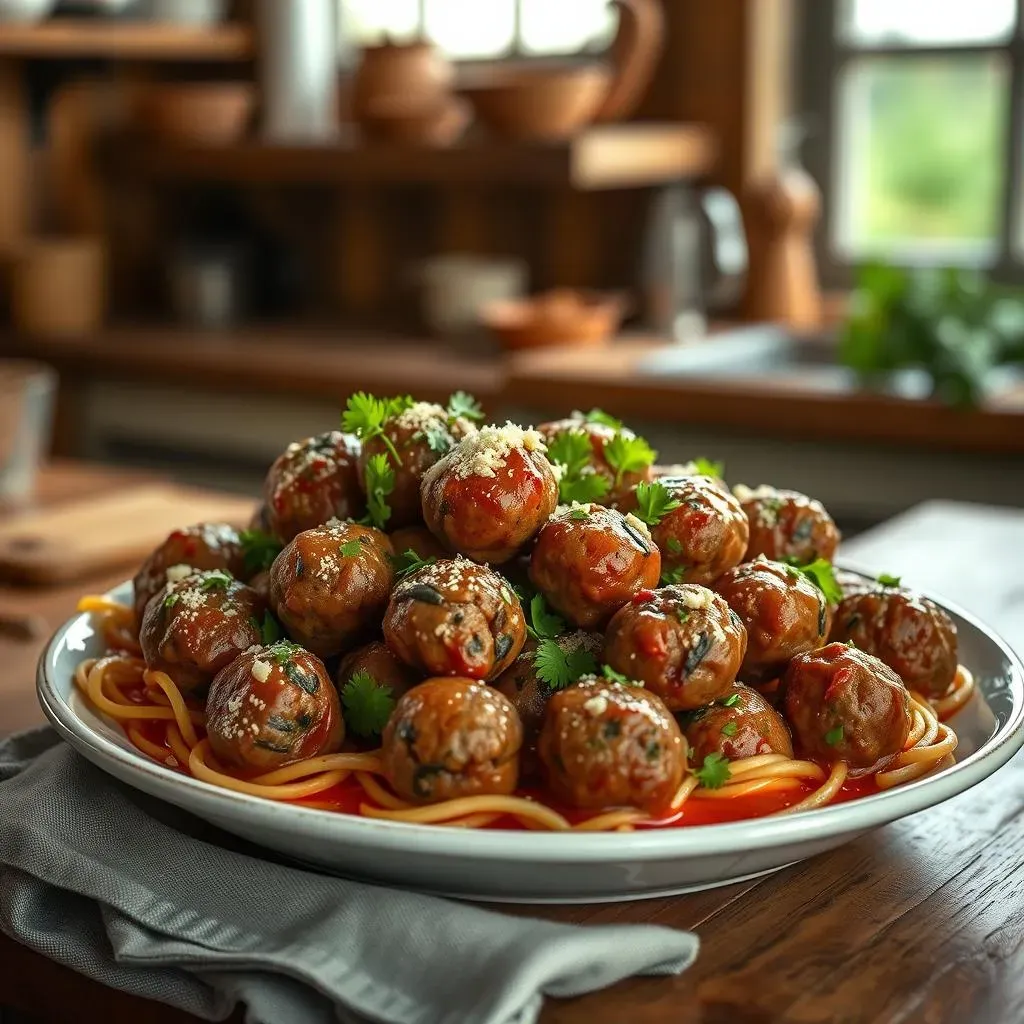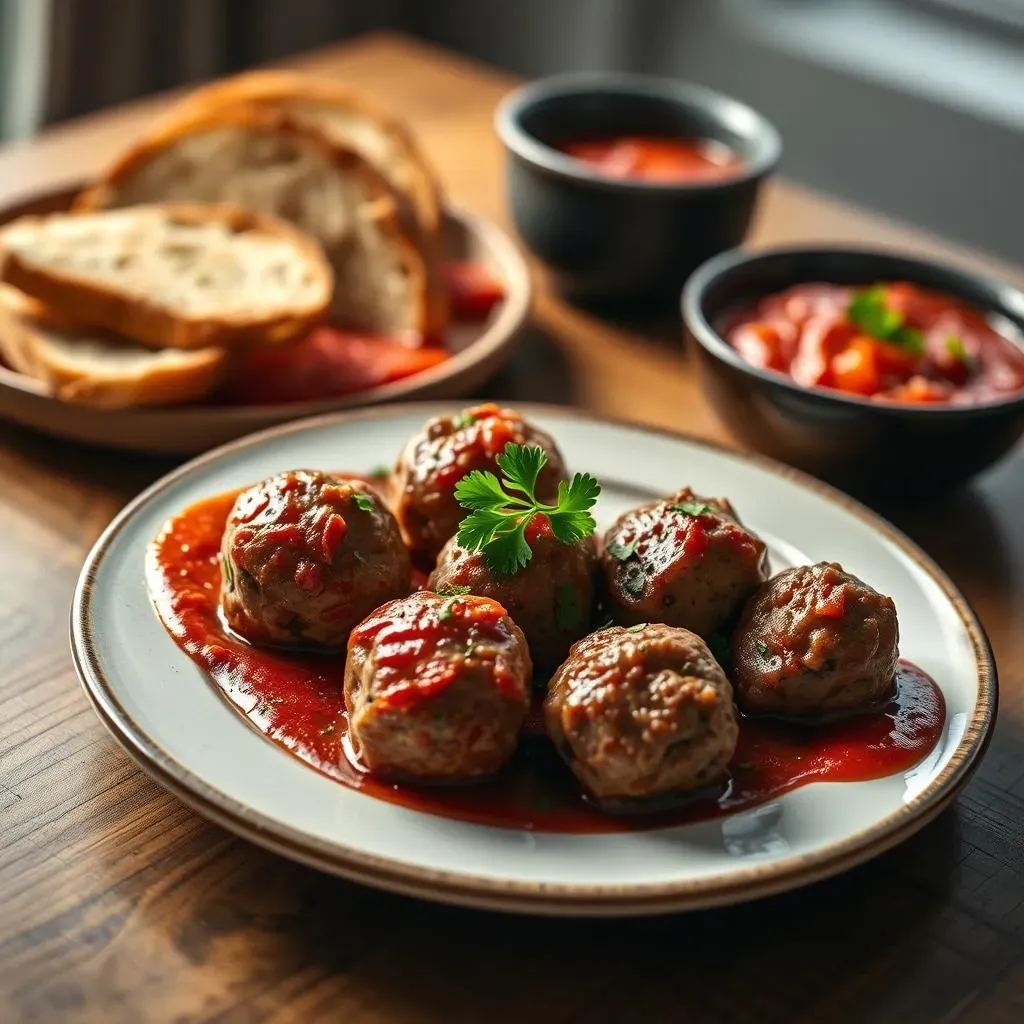Table of Contents
Are you ready to elevate your dinner game? This article is your passport to meatball mastery, specifically focusing on the delightful combination of beef and pork in a truly unforgettable meatball recipe. We'll journey together through a classic recipe, exploring the secrets to achieving perfectly juicy and flavorful meatballs every single time. Forget dry, crumbly disappointments – we’re diving deep into techniques that ensure tender, succulent results. You'll learn how to expertly blend the best cuts of beef and pork, discovering the ideal balance of fat and lean for optimal texture. We'll unravel the mysteries of the perfect meatball binder, ensuring your creations hold their shape beautifully. Beyond the basics, we'll also explore exciting variations on this classic "meatball recipe beef and pork," inspiring you to create your own signature dish. Whether you're a seasoned chef or a kitchen novice, get ready to embark on a delicious adventure! Prepare for a mouthwatering exploration of flavor and technique, resulting in meatballs so good, you'll be the envy of all your friends and family. Let's get started!
The Best Beef and Pork Meatball Recipe: A Classic Combination

The Best Beef and Pork Meatball Recipe: A Classic Combination
The Perfect Meat Blend
Let's talk about the star of the show: the meat! For the ultimate flavor and texture, I recommend a 50/50 blend of ground beef and ground pork. The beef provides a rich, savory base, while the pork adds incredible juiciness and a touch of sweetness. Think of it as a beautiful marriage of flavors – a culinary Romeo and Juliet, if you will. Don't be afraid to experiment with different ground beef options; a higher fat content (like 80/20) will result in extra moist meatballs. For a leaner option, check out our beef vs. turkey meatballs comparison!
Many recipes call for veal, but let's be honest, it's not always easy to find and can be quite pricey. This recipe proves you don't need it for amazing meatballs. This beef and pork combo is a winner, offering the best of both worlds without breaking the bank or requiring a special trip to the butcher. For more tips on choosing the right ground meat, check out our beef meatball recipe tips article.
Meat Type | Flavor Profile | Texture Contribution |
|---|---|---|
Ground Beef | Savory, Rich | Structure, Body |
Ground Pork | Sweet, Juicy | Moisture, Tenderness |
Building the Flavor Foundation
Once you've got your meat sorted, it's time to build a flavor foundation that will make these meatballs sing. We're talking fresh herbs – think parsley, oregano, and basil – finely minced garlic, a touch of onion (both add sweetness and depth), and a little grated Parmesan cheese for a salty, umami punch. Don't forget salt and pepper; these are essential for seasoning any dish, including this one. A little freshly cracked black pepper adds a delightful kick to the recipe. For an extra layer of flavor, consider adding a pinch of red pepper flakes for a subtle heat.
The secret ingredient in many great recipes is often simplicity. This meatball recipe is no exception. The magic is in the quality of your ingredients and the care you take in combining them. Remember, even small details make a big difference in the final product. Consider adding a splash of Worcestershire sauce for a richer, more complex flavor profile. Want a simpler approach? Try our 4-ingredient meatballs recipe!
- Finely minced garlic
- Fresh parsley
- Grated Parmesan cheese
- Salt and freshly cracked black pepper
- Optional: Red pepper flakes for a subtle heat
The Binding Agent: Breadcrumbs and Beyond
Now, let's talk about binding. Breadcrumbs are the unsung heroes of meatball making, absorbing excess moisture and helping the meatballs hold their shape. I prefer using fresh breadcrumbs – simply pulse a few slices of day-old bread in a food processor until finely ground. But store-bought works just as well, in a pinch. Soak them in a little milk or even better, beef broth, for extra flavor and moisture. This simple step makes a world of difference.
Beyond breadcrumbs, eggs act as a natural binder, adding extra moisture and richness. One or two large eggs, lightly beaten, will do the trick. Gently incorporate them into the meat mixture, along with your herbs, spices, and soaked breadcrumbs. Don't overmix! Overmixing can result in tough meatballs. We want to keep the mixture relatively loose. For a gluten-free option, you can substitute almond flour for breadcrumbs. Explore our low-carb beef meatballs recipe for more ideas!
Mastering the Meatball: Tips and Tricks for Perfect Beef and Pork Meatballs

Mastering the Meatball: Tips and Tricks for Perfect Beef and Pork Meatballs
Gentle Handling is Key
Remember, the key to juicy, tender meatballs isn't brute force; it's gentle handling. Mix your meatball ingredients with care, just until everything is combined. Overmixing develops the gluten in the breadcrumbs and toughens the meat. Think of it like kneading bread – you want to incorporate the ingredients without overworking the dough. Aim for a slightly loose mixture; it will firm up as it cooks. For more ideas on achieving the perfect texture, check out our guide on beef meatball recipe variations.
Once you've gently combined all the ingredients, cover the bowl and refrigerate the mixture for at least 30 minutes. This chilling step allows the flavors to meld and makes the meatballs easier to shape. Think of it as a little pre-party for your ingredients—a chance to get to know each other before the main event! If you're short on time, you can skip this step, but chilling always improves the final result. For a quick weeknight meal, check out our easy ground beef meatball recipe.
- Mix gently, avoid overmixing.
- Refrigerate for at least 30 minutes (or longer).
- Chill for better shaping and flavor.
Shaping and Sizing: The Art of the Meatball
Now for the fun part: shaping your meatballs! Using a spoon or your hands (lightly oiled to prevent sticking), roll the meat mixture into even-sized balls. Consistency is key here, as it ensures even cooking. Aim for meatballs that are roughly 1 1/2 to 2 inches in diameter. Smaller meatballs will cook faster, while larger ones will need more time to reach the desired internal temperature. For a truly impressive presentation, try using an ice cream scoop to create perfectly uniform meatballs. Looking for a make-ahead option? Our make-ahead beef meatballs recipe is perfect for busy schedules.
Remember, you don't need to be a sculptor to make beautiful meatballs. Even slightly imperfect shapes will taste delicious! Just focus on making them relatively uniform in size. This will ensure even cooking and prevent some meatballs from becoming overcooked while others remain underdone. For more advanced techniques, you might want to check out our meatball recipes with ground beef for some inspiration.
Meatball Size | Cooking Time | Notes |
|---|---|---|
1 1/2 inches | 15-20 minutes | Quick and easy |
2 inches | 20-25 minutes | More substantial |
Cooking Methods: Oven, Stovetop, or Slow Cooker?
There are several ways to cook your amazing beef and pork meatballs, each offering a unique flavor and texture. Baking in the oven is a hands-off method that results in evenly cooked meatballs with a slightly crispy exterior. Simply arrange them on a baking sheet lined with parchment paper and bake at 375°F (190°C) until cooked through. Pan-frying offers a richer, more browned flavor, but requires more attention. Sear the meatballs in a skillet over medium heat, turning occasionally, until golden brown and cooked through. For a truly low-effort approach, try using a slow cooker. Simmer the meatballs in your favorite sauce for several hours until tender and flavorful.
The best cooking method ultimately depends on your preferences and available time. Baking is generally the easiest and most consistent, while pan-frying delivers a more intense flavor. The slow cooker provides the ultimate convenience, perfect for a weekend meal. No matter which method you choose, always use a meat thermometer to ensure the meatballs reach an internal temperature of 165°F (74°C) to guarantee they are fully cooked. For a complete guide, check out our baked beef meatball recipe and our reheating beef meatballs guide.
Beyond the Basics: Creative Variations on Your Beef and Pork Meatball Recipe

Beyond the Basics: Creative Variations on Your Beef and Pork Meatball Recipe
Spice it Up: Global Flavor Adventures
Let's take our classic beef and pork meatballs on a culinary journey around the world! Imagine the vibrant flavors of a Moroccan tagine, the fragrant spices of an Indian curry, or the zesty kick of a Mexican salsa verde. The possibilities are endless! For a spicy kick, incorporate a blend of chili powder, cumin, and smoked paprika into your meat mixture. A dash of harissa paste adds a fiery North African flair. For a more subtle heat, try adding a few finely chopped jalapeños or serrano peppers. Check out our Italian sausage and ground beef meatball recipe for a flavorful twist.
Don't be afraid to experiment with different spice combinations. The beauty of cooking is the freedom to personalize your dishes to your taste preferences. A little experimentation can lead to exciting new flavors and culinary discoveries! For a milder approach, consider adding herbs like thyme or rosemary. For a completely different flavor profile, try our ground beef and sausage meatballs.
- Moroccan Spices: cumin, coriander, turmeric
- Indian Spices: garam masala, curry powder, ginger
- Mexican Spices: chili powder, cumin, oregano
Cheese Please: Adding a Melty, Gooey Center
Elevate your meatballs to a whole new level of deliciousness by adding a molten cheese center. Imagine biting into a meatball and discovering a burst of creamy, melty goodness! Before shaping your meatballs, create a small indentation in the center of each one. Fill the indentation with your favorite cheese – mozzarella, provolone, or even a sharp cheddar will work beautifully. Then, carefully close the meatball around the cheese, ensuring it's fully enclosed. The cheese will melt beautifully during the cooking process, creating a truly decadent treat. For a richer flavor, try adding some ricotta cheese to the meat mixture. Explore our meatball recipe using ground beef for more ideas.
Experiment with different types of cheese to find your perfect combination. Consider using a blend of cheeses for a more complex flavor profile. For instance, a mix of mozzarella and Parmesan would offer both creaminess and a salty, umami punch. For a unique twist, try incorporating crumbled blue cheese or goat cheese for a tangy, unexpected flavor. Remember, the possibilities are endless when it comes to cheese! For a simple approach, try our simple ground beef meatball recipe.
Cheese Type | Flavor Profile | Texture |
|---|---|---|
Mozzarella | Mild, Creamy | Stretchy |
Provolone | Sharp, Nutty | Firm |
Cheddar | Sharp, Tangy | Dense |